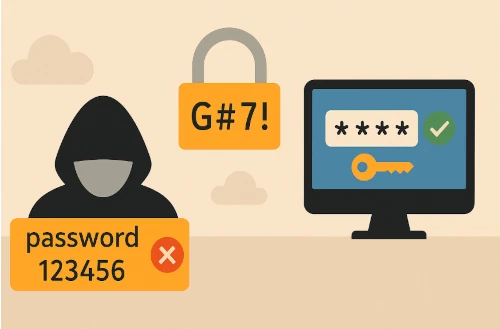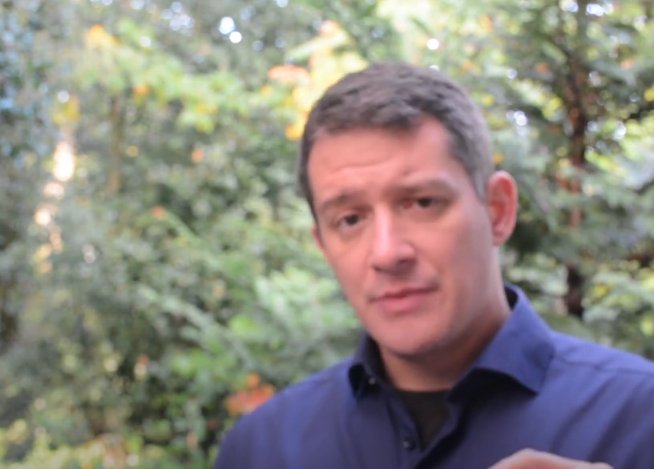We’re surrounded by passwords. They guard our messages, our memories, our accounts. Some even protect our money and our digital identity. And yet, it’s often these little gatekeepers that are easiest to get around. Not because they’re fundamentally weak – but because we make it far too easy. For them. Or rather, for the attackers.
The Familiar Pattern
Most people pick passwords that are easy to remember. The dog’s name. A child’s birth year. Or just: “123456”. It’s understandable – no one wants to think too hard. But that’s exactly where the problem starts.
There’s a public list of the most common passwords, compiled from leaked data – for example here:
👉 Wikipedia: List of the most common passwords
One glance is enough to see: these aren’t just weak passwords – they’re well known. Using one is like leaving your front door wide open.
The Mistake of Reusing Passwords
What makes things even worse: password reuse. One password for everything. If one service gets hacked, it’s like you’ve handed over the master key. From there, it’s a short path to identity theft, blackmail, or losing your accounts altogether.
Am I Affected?
Check out the free service haveibeenpwned.com – it shows if your email or passwords have been found in any known data breaches. No login required. Totally discreet.
If you’re affected, change your password right away. Not to a variation – to a brand new, unique one. Best done with a password manager.
Why Strong Passwords Matter
A regular home computer can try millions of passwords per second. It’s called brute force. And it works – if your password is weak.
Example:
sonne123 → cracked in seconds
G#7wP!z4mVq@U3 → would take millions of years to crack
The Fix: Tech That Works – If You Use It
You don’t need to memorize every password. You just need to change your habits.
Password managers like KeePass or Bitwarden do the heavy lifting. They store your passwords encrypted, help you generate strong ones, and autofill them when needed. Saves time – and headaches.
The Second Door: Two-Factor Authentication (2FA)
A strong password protects you.
2FA protects you twice.
Even if someone gets your password, they still can’t log in without the second factor: a code that changes every 30 seconds, generated by an app like Aegis Authenticator.
According to Microsoft, 2FA blocks over 99% of automated attacks.
Use 2FA especially for:
- Your main email account
- Online banking
- Cloud services (Google Drive, Dropbox, iCloud)
- Social media
- Your password manager
Warning: No Backup = No Access
If you lose your phone and your 2FA app is gone, you’ll be locked out – even you won’t be able to log in.
So make sure you back up your 2FA keys. Depending on the app, you can:
- Create an encrypted backup (e.g. in Aegis)
- Print out the QR codes and store them safely
- Export them to a second device
Your password manager also needs a backup – ideally offline and encrypted, e.g. on a USB stick stored in a drawer or safe.
Please Don’t: Passwords in a Text File or on Paper
A lot of people do this: they save all their passwords in a file called passwords.txt. Or scribble them on a sticky note under the keyboard.
That’s not security. That’s an open invitation.
One virus, one curious visitor, one unattended laptop – and it’s game over.
Passwords belong encrypted. Either in your head (just one master password) or in a vault.
One More Step: Separate Email Addresses
Most people use one email address for everything.
But if that one email gets compromised, almost everything else is at risk.
Better:
- One email for finances and important stuff
- One for personal communication
- One for shops, forums, newsletters
It keeps things tidy – and more secure.
Identity Theft: A Painful Example
Imagine someone hacks into your Facebook account. Changes the password, email, enables 2FA – you’re locked out. Then they message your friends:
“Hey, I’m stuck abroad, got my wallet stolen. Can you send me €300 via PayPal?”
Many would help. And you won’t know until someone checks in on you.
Identity theft is real. And often stupidly simple.
But the consequences can be huge: reputation damage, lost money, or losing access to your digital life.
The 30-Day Digital Security Challenge
Want to make your digital life safer – without the overwhelm? Take 30 days. One small step per day:
Week 1: Awareness & Overview
- ✅ Read this article
- Check your email on haveibeenpwned.com
- List all the services you use
- Mark the important ones (bank, mail, cloud)
- See where you’ve reused passwords
- Start changing one of them
- Install a password manager (KeePass or Bitwarden)
Week 2: Build Your Password System
- Create a strong master password
- Add your key logins to the vault
- Learn to use autofill
- Back up your password vault
- Export an encrypted backup
- Store an offline backup on a USB stick
- Delete old password text files
Week 3: Turn On 2FA
- Install the Aegis Authenticator app
- Enable 2FA on your main email
- Enable 2FA on your password manager
- Enable 2FA on social media
- Enable 2FA on financial apps
- Enable 2FA on cloud services
- Back up your 2FA setup (e.g. save QR codes)
Week 4: Optimize & Clean Up
- Create a second email for important accounts
- Separate private from public services
- Review old accounts – delete what you don’t need
- Remove saved passwords from your browser
- Enable notifications for sensitive accounts
- Share this info with friends or family
- Print an emergency access sheet for your accounts
- Recheck haveibeenpwned.com
- Sit back – you did it 🎉
Feel free to forward this article to someone who’s still using “password123”.
From Our Blog

17. August 2025
How a DHS can turn chronic
A brief explanation of how biological conflicts can enter a recurring cycle and appear like a cronic disease.

14. August 2025
The three types of being sick
There is three ways of being sick and they are very different.

23. July 2025
Invisible Doors – Why Weak Passwords Don’t Really Protect You
How Secure Is Your Digital Life? Most people use weak passwords – and often reuse them. This article explains why that’s risky, how you can protect yourself, and what 2FA actually does. 👉 Plus: a 30-day challenge to boost your security step by step.

05. January 2025
The biological meaning in the context of time
"Explore Dr. Hamer's theories on illnesses as evolutionary 'special programs,' highlighting the role of conflict duration, natural timelines, and the biological significance of disease processes."

04. January 2025
Presentation at the Open Day, Bergamo 2019
On January 26, 2019, during the Open Day of the Academy for the 5 Biological Laws in Bergamo, Italy, a lecturer showcased the academy's teaching methods. Using a small experiment, they demonstrated how effective learning strategies can help grasp unfamiliar concepts quickly, highlighting the academy’s innovative approach to making complex topics accessible.

22. October 2019
Nutrition and the 5 laws of nature
The text explores the connection between the 5 Biological Laws (5BN) and nutrition, emphasizing how active "special programs" can influence biochemical needs and create specific demands for certain nutrients like protein, salt, or calcium. It highlights that deficiencies or disruptions in nutrient processing can stall healing processes, which may be resolved through dietary adjustments or supplements. The core idea is that physical, psychological, and biochemical levels are interconnected, and interventions on any level can impact the overall process.